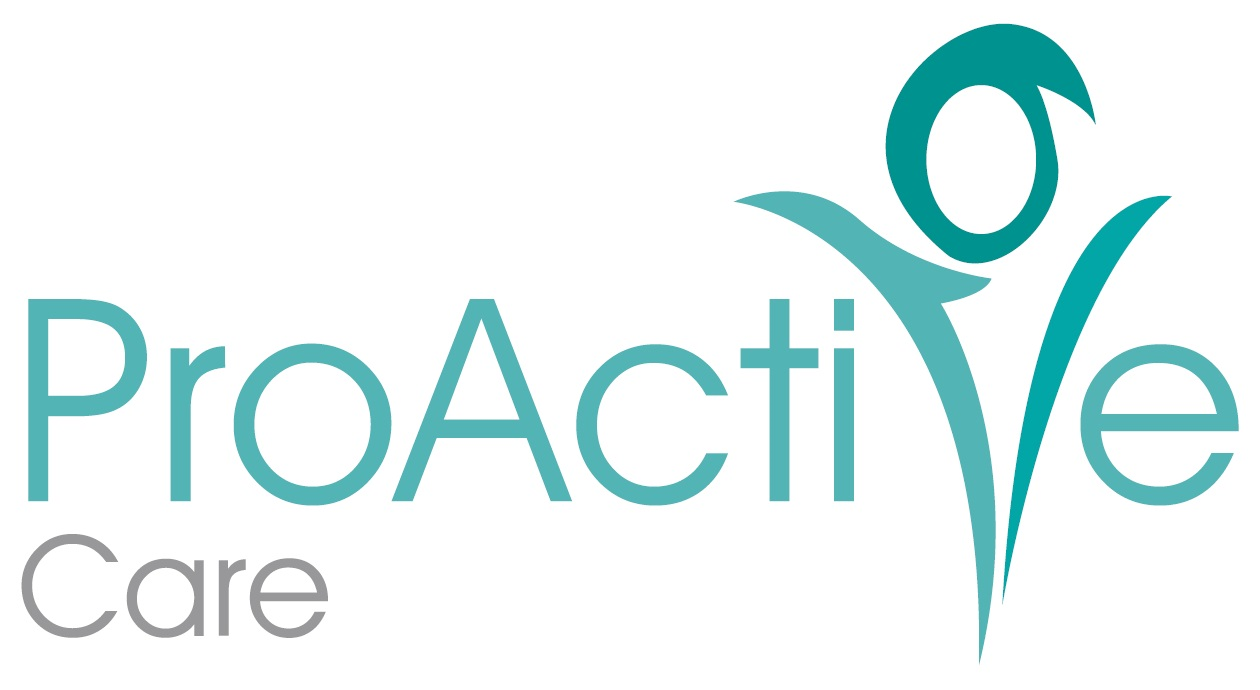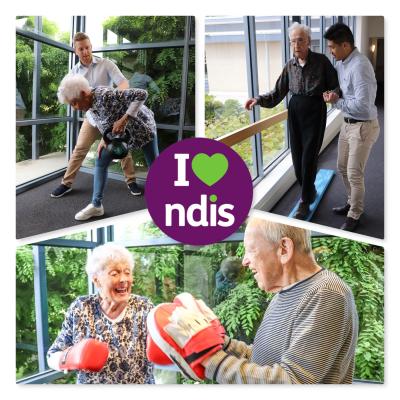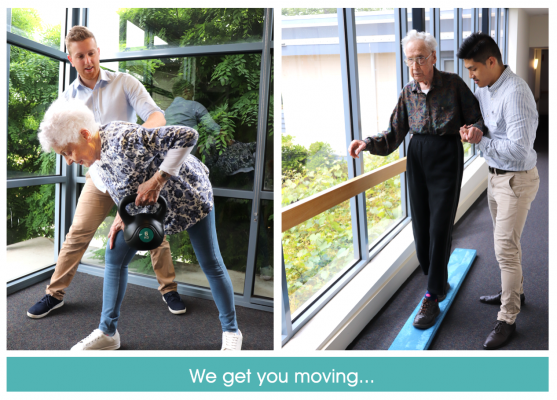Use of mechanical lifting hoist and slings for transfer of residents in residential aged-care facility is common practice to ensure safety of both the resident and care staff. However inappropriate use or application can also result in injuries to both parties. In the Australian Aged-care industry, there were instances where the inappropriate use of mechanical lifting equipment attributed to death of residents. It was identified that a gap in knowledge exists in care staff concerning best practice guidelines for use of hoists and slings. This article aims to offer clarity and provide basic guidelines for nurses and care staff in residential aged-care by 1) educating correct use of and prescription of hoist and slings, 2) ensuring safety and minimise risk for residents and staff, and 3) improving staff confidence in their delivery of care.
WHAT ARE HOISTS & SLINGS USED FOR?
Mechanical lifting or standing equipment and associated slings are used for residents with poor mobility and require high degree of physical assistance for transfers. Mechanical application of force is generated by the hoist, which acts directly upon a resident via the sling against gravity, in order to transfer the resident. Manual “lifting” of residents by nurses and care staff is not recommended and has been deemed unsafe in the Aged-care industry due to numerous cases of injuries and even deaths. Thus, most (if not all), residential aged-care facilities in Australia adopt a “no lift” policy with regards to manual handling.
WHICH HOIST TO USE?
Lifting Hoist:
A lifting hoist is used for residents who are non-weight bearing. It lifts the resident vertically, allowing staff to transfer or reposition the resident over a very short distance (up to 2 meters). It is also used to allow care staff to attend to ADLs. It is not appropriate for resident to remain suspended in the lifting hoist for a prolonged period of time. There are two types of lifting hoists, a free-standing lifting hoist, and a ceiling lifting hoist.
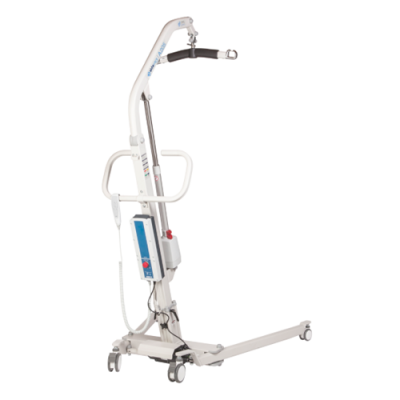
Example of a free-standing lifting hoist
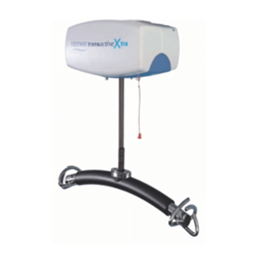
Example of a ceiling lifting hoist
Standing Machine:
A standing machine is used for residents who has reduced lower limb strength, but is able to stand with physical assistance. This equipment facilitates the resident around the mid back to reduce the work of standing. The resident must be able to weight-bearing, self-assist with transfer, follow instructions, and have good trunk and neck control to be appropriate for standing machine transfer.
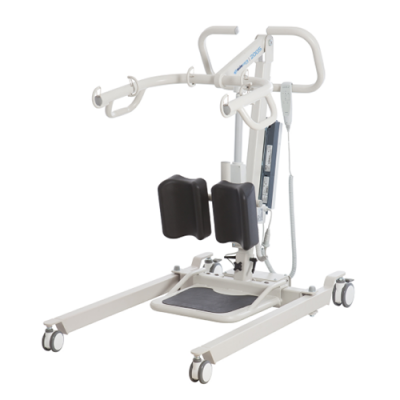 Example of a standing machine
Example of a standing machine
Your Physiotherapist or Occupation Therapist is trained to assess a physical capability of the resident and recommend the safest and most appropriate equipment and method of transfer.
WHICH SLING TO USE?
General Purpose Sling
This sling is to be used in conjunction with a lifting hoist only. It is for residents who are non-weight bearing and is unable to self-assist with the transfer process. This hammock-like sling fully wraps around the resident’s head, trunk and legs. The leg supports can either hold each leg separately, or can be crossed over to hold legs closely together (depending on hoist type and manufacturer).
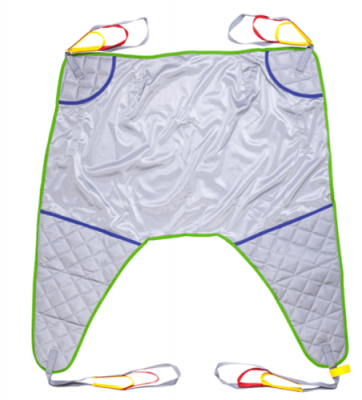
Toileting/Access Sling
This sling is to be used in conjunction with a lifting hoist only. It is for residents who are non-weight bearing, but able to self-assist with the transfer process. Not suitable for residents with very weak trunk control and unable to follow staff instructions. The toileting/access sling supports the upper back, and wraps around the armpits, then down to the waist and the thigh, leaving the resident’s bottom unsupported and uncovered for hygiene tasks. It can be used to position residents over a toilet or a commode. The Velcro & buckle strap must applied around the waist firmly. Leg supports can either hold each leg separately, or can be crossed over to hold legs closely together (depending on hoist type and manufacturer).
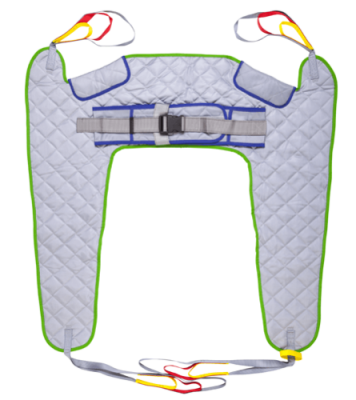
Standing Machine Sling
This sling is to be used in conjunction with a standing machine only. It is for residents who are still weight-bearing, able to self-assist with the transfer process, and able to follow staff instructions.
It is not suitable for residents who are non-weight-bearing, have with very weak trunk/head control unable to self-assist with transfer and unable follow staff instructions. The standing machine sling supports the mid back, and wraps around the armpits, then on to the standing machine directly in front of the resident. The Velcro & buckle strap must applied around the waist firmly and both feet planted on the footrest.
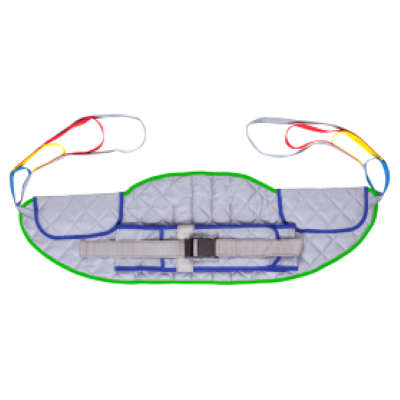 Correct Sizing:
Correct Sizing:
All slings will have a specific size and the recommended limit of height, weight and girth printed somewhere visible. Prior to application of slings, it is imperative for care staff to check and ensure that the sling being used is appropriate for the resident.
| Size | Edging Colour | Girth | Height | S.W.L |
| Small | Red | 65 – 95 cm | 120 – 160 cm | 200 kg |
| Medium | Yellow | 77 – 110 cm | 140 – 175 cm | 200 kg |
| Large | Green | 98 – 135 cm | 158 – 185 cm | 300 kg |
| X-Large | Blue | 118 – 157 cm | 165 – 193 cm | 300 kg |
Example of a size chart
Your Physiotherapist or Occupation Therapist will be able to assist you in ensuring the correct sling type and size is used for the resident.
IMPORTANCE OF POLICIES & PROCEDURES
Previous Coroner’s Reports from adverse events around Australia has laid out some useful recommendations for implementation in residential aged-care facilities to optimise safety during hoists and slings usage. Implementing up-to-date policies and procedures will to ensure the most appropriate guideline and support are given to staff members on the floor working with residents.
Providing appropriate structured education and training for nursing and care staff, including regular refresher courses, will ensure all operators of hoists and slings are fully informed on best practice guidelines. It should also contain input from Physiotherapists or Occupational Therapists, and include clear guidelines for different types of slings, appropriate choice of slings, correct sling configuration, and correct adjustment of straps.
Scheduled servicing and maintenance of hoists and slings is important in ensuring all equipment being used are in safe and working order.
Finally, it is highly beneficial for facility management to keep records of staff training and equipment maintenance as evidence and data for continuing improvement.
HOW PROACTIVE CARE CAN HELP?
Here at ProActive Care, we are experts in hoists and slings, and we are eager to help your facility and your staff members. Our physiotherapists are able to conduct functional assessment for residents, and provide appropriate recommendations for method of transfer, equipment to use, and type of sling to use. We also offer formal Manual Handling Training and Competency Assessments for nurses and care staff, to ensure they have the knowledge and confidence to use transfer equipment safely. Contact us for more information on innovative ways we can help to ensure safe use of hoists and slings at your facility.
(All images of equipment sourced from aidacare.com.au)
